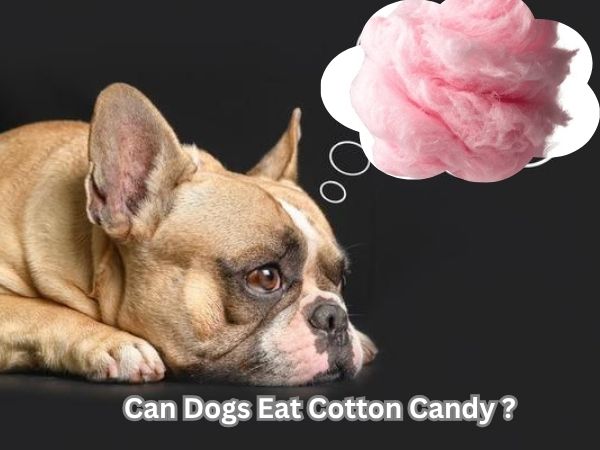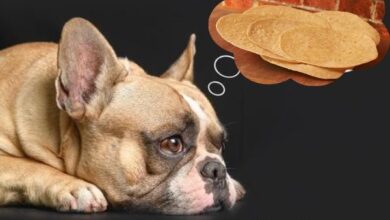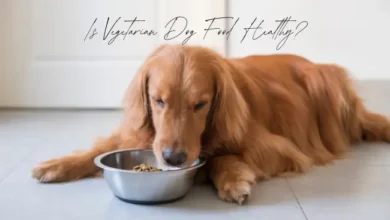Can Dogs Eat Cotton Candy? Shocking Truth You Should Know

MixbreedDogs.com is an Amazon Associate, and we earn from qualifying purchases.
Can dogs eat cotton candy? Cotton candy is a popular treat at fairs and carnivals. If you are thinking about sharing some with your dog, you might wonder if it is safe. Many people like to give their pets a taste of what they are eating, but not all human foods are good for dogs. Should you let your dog have cotton candy?
Cotton candy is not safe for dogs. It is mostly sugar and has no nutritional value. Even a small amount can upset your dog’s stomach. Too much sugar can cause weight gain or diabetes. Some cotton candy may have xylitol or chocolate, which are toxic to dogs. The texture can also be a choking risk, especially for small dogs. It is better to choose a safer treat for your dog.
Why This Guide Matters
If you’re like me, you love your dog and you probably love fairs and carnivals too—especially that sweet, fluffy cotton candy. It’s only natural to wonder if sharing a little bit is safe. In my experience, sugary and sugar-free treats can cause all sorts of problems for dogs, from upset stomachs and extra pounds to more serious health issues. Statistics show that xylitol poisoning cases have increased by 230% between 2013 and 2018, with nearly 20,000 cases reported to Pet Poison Helpline. This guide will walk you through what you need to know, with advice you can trust. I’ve gathered information from trusted veterinary sources and included a simple emergency plan, so you’ll know exactly what to do if your dog gets into cotton candy.
Can Dogs Eat Cotton Candy?
Dogs really shouldn’t have cotton candy. Even if a tiny bite doesn’t make them sick right away, it’s still not safe for your pup.
Here’s something important to know: plain cotton candy made with just sugar isn’t technically toxic, but that doesn’t mean it’s safe. There’s a big difference between these two terms. Toxic means something will poison your dog right away, while unsafe means it can seriously harm their health even if it doesn’t cause instant poisoning. Cotton candy falls into the unsafe category because of what it does to your dog’s body.
Cotton candy is just spun sugar with some artificial colors and flavors. Dogs can’t handle sugar like we do. Their stomachs aren’t built for that much sweetness, so eating it can quickly lead to vomiting or diarrhea. Too much sugar upsets their stomach and makes them feel pretty awful.
What Is Cotton Candy, Really? What Is Cotton Candy Made Of?
The Traditional Kind
Regular cotton candy is simply white granulated sugar combined with artificial flavorings and food dyes, then spun into delicate, thread-like strands. That’s it—no hidden ingredients, but also no nutritional benefits whatsoever. This fluffy treat contains no fiber, protein, vitamins, or minerals—just pure sugar in its most tempting form. The bright pink and blue colors come from artificial dyes like Red #40 and Blue #1, while the signature taste comes from synthetic flavoring agents such as ethyl maltol and vanilla extracts. Since cotton candy offers zero nutritional value, it’s definitely not a smart choice for dogs who need real, wholesome nutrients in their diet.
The “Sugar-Free” Version
Some brands make sugar-free cotton candy with artificial sweeteners, which is even more dangerous for dogs. If it has xylitol (sometimes called birch sugar or wood sugar), it’s extremely toxic. Xylitol can cause a sudden drop in blood sugar and may lead to serious liver damage or even liver failure. If you’re not sure whether the cotton candy has xylitol, it’s safest to keep it away from your dog.
Why Cotton Candy Is Dangerous for Dogs
Cotton candy might look fun, but it’s not safe for dogs. This sugary treat can cause everything from stomach problems to long-term health issues, and it can even be a choking hazard.
Excessive Sugar Content
Dogs can’t digest sugar like we can. When they eat sugary foods like cotton candy, it’s just empty calories with no benefit. All that sugar puts extra stress on their bodies and can make them feel tired and unhealthy over time.
Short-Term Health Risks
Giving a dog cotton candy can cause:
- Belly upset, including vomiting and diarrhea.
- Stomach pain and discomfort
- Hyperactivity (“sugar rush”), followed by a crash that leaves them very tired
- General lethargy and lack of energy after the sugary high
Even a single bite can upset your dog’s stomach, since their bodies aren’t built to handle sugar.
Long-Term Health Complications
Regularly eating sugary treats like cotton candy can lead to:
- Obesity and unhealthy weight gain
- Diabetes mellitus, a serious lifelong condition
- Dental problems like tooth decay, cavities, and gum disease
- Pancreatitis (inflammation of the pancreas), which is painful and can be life-threatening
- Heart and liver problems as the body tries to process excess sugar
- Weakened immune system, making dogs more prone to illness.
Choking Hazards
Cotton candy’s light, sticky texture can get stuck in a dog’s throat and make it hard to breathe. The fluffy strands might block their airway or cause a blockage in their stomach if swallowed. This is a real risk that could mean an emergency trip to the vet.
The best thing you can do is keep cotton candy and other sugary snacks away from your dog. Choose dog-safe treats with real nutrition instead. That way, your pup stays healthy and happy.
Hidden Dangers in Cotton Candy
Cotton candy might be a fun treat for people, but for dogs, it can hide some real dangers. Here’s what you should know before letting your pup near this sugary snack.
Xylitol Toxicity
Some sugar-free cotton candy brands use xylitol as an artificial sweetener. While this ingredient is safe for people, it’s extremely toxic to dogs.
- Xylitol causes a dog’s body to release insulin fast.
- This drop in blood sugar leads to weakness, wobbling, vomiting, and even seizures.
- Even small amounts may cause severe hypoglycemia, liver failure, or death—especially for smaller breeds.
- If a dog eats xylitol, call a vet right away.
Chocolate Cotton Candy
Chocolate-flavored cotton candy may contain theobromine, a chemical in chocolate that is highly toxic to dogs.
Common symptoms include:
- Vomiting and diarrhea.
- Increased thirst, urination, and panting.
- Racing heart or irregular heartbeat.
- Seizures, tremors, hyperactivity, and fever.
- In severe cases, heart failure or coma may occur.
Artificial Colors and Flavors
Many cotton candy products have artificial colors and flavors added for fun and taste.
- These additives don’t do anything good for your dog.
- They can upset your dog’s stomach and cause vomiting, diarrhea, or pain.
- Dogs with sensitive stomachs or allergies might react even worse.
Actionable Advice
- Keep cotton candy, especially sugar-free or chocolate varieties, far away from dogs.
- Always check labels for xylitol and artificial additives.
- If a dog accidentally eats cotton candy, watch for symptoms and call the vet.
Remember, giving safe treats is the best way to show your dog you care. A little awareness helps keep your pup happy and healthy.
What Happens If My Dog Accidentally Eats Cotton Candy?
If your dog eats a small amount of cotton candy, it’s usually not life-threatening, but it’s still not good. Most of the time, a little bit just leads to an upset stomach for a few hours.
Small Amounts: What to Expect
- Most dogs are okay if they just get a taste of cotton candy. They might have a stomach ache, a little vomiting, or mild diarrhea that goes away in a day.
- Extra sugar, artificial flavors, and colors aren’t good for your dog’s health, so it’s best not to make this a habit.
- Just remember, even if cotton candy is fun for people, it has no nutritional value for dogs.
When to Call the Vet
There are times when extra caution is needed. Call the vet right away if:
- The dog ate a large amount of cotton candy.
- The cotton candy contained xylitol (a sugar substitute extremely toxic to dogs) or chocolate.
- The dog is showing distress, such as:
- Repeated vomiting
- Severe diarrhea or trouble keeping water down
- Lethargy, weakness, or collapse
- Seizures, shakiness, or loss of coordination
- Excessive drooling or panting
Watch out for any symptoms. If the cotton candy had xylitol or chocolate, get emergency help immediately, since these can cause severe vomiting or death in dogs. Calling your vet quickly can give you peace of mind and help keep your dog safe.
Most dogs bounce back from a tiny taste of cotton candy with just a mild stomach upset. But if your dog eats a lot, or you think there are toxic ingredients, don’t wait—call your vet for advice. And always keep sweet treats out of reach to keep your pup healthy and happy.
Safe Treat Alternatives for Dogs
Good treat options for dogs are store-bought dog treats, fresh fruits and veggies, dental chews, and simple homemade snacks. The main thing is to keep treats healthy and tasty so your dog stays happy and well.
Commercial Dog Treats
Pick treats made just for dogs, with ingredients you know and trust. Choose brands that skip artificial colors, flavors, and preservatives.
- Go for treats that are low in sugar and don’t have fillers or byproducts.
- Look for treats made with real meats, fish, or vegetables for natural protein and nutrients.
- Examples: Full Moon Organic Human-Grade Treats, Castor & Pollux ORGANIX Cookies, Sojos Grain-Free Snacks, Portland Pet Food Pumpkin Treats.
Fresh Fruits and Vegetables
Many everyday fruits and veggies from your kitchen can double as healthy dog treats. Serve them in moderation and always prepare them safely.
- Carrots: Crunchy, low-calorie, good for teeth, served raw or frozen.
- Apples: Remove seeds and core; rich in vitamins, fresh and sweet.
- Blueberries: Packed with antioxidants and fiber, and easy for most dogs to eat.
- Green Beans: Low-calorie, a great crunchy snack.
- Examples in moderation: banana, cantaloupe, sweet potatoes, broccoli, squash, celery.
Dental Chews
Dental chews like bully sticks are great for chewing and help keep your dog’s mouth healthy. They last a while and most dogs love the taste.
- Bully sticks help clean teeth, cut down on bad breath, and keep your dog’s jaw strong.
- Always watch your dog during treat time and pick a size that’s right for them.
Homemade Dog Treats
Making treats at home lets you control what goes in and adds a little extra love to snack time.
- Mix plain oats, pure pumpkin (not pie filling), and natural peanut butter without xylitol to make easy, healthy biscuits.
- Stay away from sugar, chocolate, grapes, raisins, avocados, and anything with xylitol.
Example Recipe:
- 1 cup oats
- ⅓ cup pure pumpkin
- ¼ cup xylitol-free peanut butter
- Blend, shape, and bake at 300°F (150°C) for 25-30 minutes.
Healthy Treating Guidelines
Treats are wonderful, but balance is key. They should make up no more than 10% of your dog’s daily calories, with the rest coming from complete nutrition.
- Following the 10% rule helps keep your dog at a healthy weight and stops you from giving too many treats.
- Figure out how many calories your dog needs each day, then set aside a small part for treats.
- Ask your vet about calorie guidelines for your dog’s breed, age, and lifestyle.
When you treat your dog with care, you help them stay happy and healthy, one tail wag at a time!
Dogs should never have cotton candy because it’s full of sugar, has no nutrition, and can be dangerous. Even a little bit can upset your dog’s stomach, and more can cause bigger problems. Here’s what you need to know, how to keep your dog safe, and what to do if they eat cotton candy by accident.
Cotton Candy and Your Dog’s Health
Cotton candy might look harmless, but it’s risky for dogs. It’s just spun sugar, sometimes with extra colors or flavors, and it doesn’t do your dog any good. Even a small amount can cause:
- Upset stomach, including vomiting or diarrhea
- Hyperactivity followed by lethargy (that post-sugar crash)
- Risk of choking, especially for small breeds
- The dangers increase if the cotton candy contains toxic sugar substitutes like xylitol—just a small amount of xylitol can be life-threatening for dogs.
What Trusted Sources Say
Leading veterinary experts and pet wellness sites agree: cotton candy does not belong in a dog’s diet. Here’s what the pros say:
- No nutritional value: Cotton candy is all sugar, no vitamins, and no protein. Dogs need food that gives them the energy and nutrients to play, heal, and stay healthy—not just empty calories.
- Obesity and diabetes risk: Regular sugary treats set the stage for obesity, diabetes, and heart disease in the long term. Sugar also leads to dental issues, from plaque build-up to painful cavities.
- Possible choking hazard: The fluffy texture might seem fun, but if a curious pup swallows a big piece, it can get lodged in the throat, turning playtime into a scary emergency.
- Additives and artificial sweeteners: Some sugar-free cotton candy contains xylitol, which is extremely dangerous for dogs. Even a tiny dose can be fatal. Don’t risk it—if you aren’t sure what’s in it, keep it away from your dog.
The Prevention Playbook
It’s easier than you think to keep your dog safe. With a few simple steps, you and your dog can enjoy treat time without worry:
- Safe treat swaps: If your dog begs while you’re eating cotton candy, give them something safe for dogs instead. Try a small piece of apple, carrot, or a dog treat.
- Be careful at events: At fairs, parties, or family get-togethers, keep cotton candy where your dog can’t reach it. Remind guests and kids not to share their snacks, even if your dog is being extra cute.
- Teach “leave it”: This important command can literally save your dog’s life when dropped food or tempting treats are around.
- Store smart: Put cotton candy and other sweets in high cabinets or sealed containers. Don’t leave them out on tables or counters.
A Vet-Guided Emergency Plan
If your dog eats cotton candy, don’t panic—most cases end with just a tummy ache. But if any worrisome symptoms appear or if you suspect the cotton candy contained xylitol, act right away. Here’s a step-by-step guide:
- Check for choking: If your dog is coughing, pawing at the mouth, or struggling to breathe, look into their mouth (if safe) to see if you can spot the blockage. If you can’t remove it easily, seek emergency help at once.
- Watch your dog for vomiting, diarrhea, or signs they feel bad. If they only ate a little, they’ll probably feel better in a few hours.
- Look for xylitol poisoning: If the packaging says “sugar-free” or “contains xylitol,” contact your vet or an emergency animal hospital immediately. Symptoms of xylitol poisoning (weakness, unsteadiness, seizures) can show up in as little as 30 minutes.
- Call your vet: Even if your dog seems okay, it’s smart to call your vet for advice. They can tell you what to watch for and help you feel more at ease.
- Keep a pet emergency kit with your vet’s number, emergency clinic contacts, and a list of foods that are dangerous for dogs, like xylitol and chocolate.
Building a Happier, Healthier Bond
Life with a dog is about love, trust, and happy times together, not sugary snacks. Show you care by giving healthy treats and making safe choices for your dog. If you need ideas, ask your vet about homemade dog treats or safe fruits and veggies. Your dog will thank you. The best treat is a healthy, happy dog.
When you stay informed and ready, you help your dog stay safe, healthy, and happy for years to come.
Conclusion
Keep cotton candy away from dogs because it can cause serious problems, like upset stomach, vomiting, or worse. Pets are curious and may want to taste new things, but sugary treats are not safe for them. If a dog accidentally eats cotton candy, watch closely for any signs of sickness and contact a vet right away .
Key Takeaways
- Cotton candy offers zero nutritional value for dogs .
- The sugar and chemicals in cotton candy aren’t safe for pets.
- Always keep cotton candy out of reach and pick treats made for dogs instead.
- If your dog eats cotton candy, call your vet right away.
FAQ
Can dogs eat cotton candy safely?
No, dogs should not eat cotton candy. It’s full of sugar and sometimes artificial sweeteners like xylitol, which is toxic to dogs. Even a small amount can upset their stomach and cause vomiting or diarrhea. Always keep cotton candy away from pets.
What happens if a dog eats cotton candy?
If your dog eats cotton candy, they might experience stomach pain, hyperactivity, or diarrhea. If it contains xylitol, it can cause low blood sugar, seizures, or liver failure. Contact your vet immediately if you suspect your dog ate xylitol.
Why is cotton candy bad for dogs?
Cotton candy is bad for dogs because it contains high sugar levels and artificial ingredients. Dogs cannot process large amounts of sugar, which may lead to obesity, diabetes, and dental problems. Xylitol, often found in sugar-free versions, is extremely dangerous.
Can one piece of cotton candy hurt my dog?
Even one piece can upset your dog’s stomach. While small amounts of plain sugar may not cause lasting harm, xylitol or artificial coloring can be toxic. It’s always safer to avoid giving any cotton candy to your dog.
What should I do if my dog ate cotton candy?
Check the ingredients right away. If it contains xylitol, go to the vet immediately. For regular sugar-based cotton candy, watch for signs like vomiting, diarrhea, or restlessness. Provide water and call your vet if symptoms don’t improve quickly.



